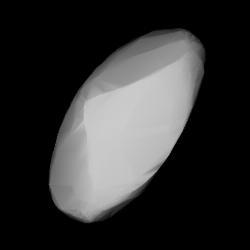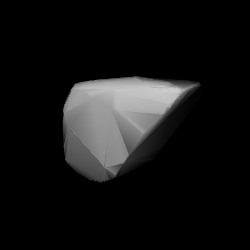Related Research Articles

1500 Jyväskylä, provisional designation 1938 UH, is a stony Florian asteroid from the inner regions of the asteroid belt, approximately 7 kilometers in diameter. It was discovered on 16 October 1938, by Finnish astronomer Yrjö Väisälä at the Turku Observatory in Southwest Finland. It was named for the Finnish town Jyväskylä.
2024 McLaughlin, provisional designation 1952 UR, is an asteroid from the inner regions of the asteroid belt, approximately 8 kilometer in diameter. It was discovered 23 October 1952, by the Indiana Asteroid Program at Goethe Link Observatory near Brooklyn, Indiana, and named after American astronomer Dean Benjamin McLaughlin.
2244 Tesla, provisional designation 1952 UW1, is a carbonaceous asteroid from the central region of the asteroid belt, approximately 25 kilometers in diameter. It was discovered on 22 October 1952, by Serbian astronomer Milorad Protić at the Belgrade Observatory, then Federal People's Republic of Yugoslavia, now Serbia. It is named after the inventor Nikola Tesla.
3067 Akhmatova, provisional designation 1982 TE2, is a stony Flora asteroid from the inner regions of the asteroid belt, approximately 6 kilometers in diameter.
2175 Andrea Doria, provisional designation 1977 TY, is a stony Florian asteroid from the inner regions of the asteroid belt, approximately 4 kilometers in diameter.

2839 Annette is a bright Flora asteroid from the inner regions of the asteroid belt. It was discovered on 5 October 1929, by American astronomer Clyde Tombaugh at Lowell Observatory during his search for Pluto. The presumed S-type asteroid has a rotation period of 10.5 hours and measures approximately 5 kilometers in diameter. It was named after the discoverer's daughter.
2033 Basilea, provisional designation 1973 CA, is a stony asteroid from the inner regions of the asteroid belt, approximately 6 kilometers in diameter. It was discovered on 6 February 1973, by astronomer Paul Wild at the Zimmerwald Observatory near Bern, Switzerland. The asteroid was named for the Swiss city of Basel.
2034 Bernoulli, provisional designation 1973 EE, is a stony asteroid from the inner regions of the asteroid belt, approximately 9 kilometers in diameter.

2490 Bussolini is an Eunomia asteroid from the central region of the asteroid belt, approximately 12 kilometers in diameter. It was discovered on 3 January 1976, by staff members of the Félix Aguilar Observatory at El Leoncito Complex in Argentina. The asteroid was named after Argentine Jesuit physicist Juan Bussolini.
2032 Ethel, provisional designation 1970 OH, is a dark background asteroid from the outer regions of the asteroid belt, approximately 36 kilometers in diameter. It was discovered on 30 July 1970, by Soviet astronomer Tamara Smirnova at the Crimean Astrophysical Observatory in Nauchnyj, on the Crimean peninsula. The asteroid was named after Irish writer Ethel Voynich.
1569 Evita, provisional designation 1948 PA, is a dark background asteroid from the outer regions of the asteroid belt, approximately 36 kilometers in diameter. It was discovered on 3 August 1948, by astronomer Miguel Itzigsohn at the La Plata Astronomical Observatory in Argentina. The asteroid was named after Eva Perón.
1938 Lausanna, provisional designation 1974 HC, is a stony Florian asteroid from the inner regions of the asteroid belt, approximately 8 kilometers in diameter. It was discovered on 19 April 1974, by Swiss astronomer Paul Wild at Zimmerwald Observatory near Bern, Switzerland. It is named for the city of Lausanne.
2056 Nancy, provisional designation A909 TB, is a stony background asteroid from the inner regions of the asteroid belt, approximately 10 kilometers in diameter. It was discovered on 15 October 1909, by German astronomer Joseph Helffrich at Heidelberg Observatory in southwest Germany. The S-type asteroid has a tentative rotation period of 15.0 hours. It was named for Nancy Marsden, wife of British astronomer Brian G. Marsden.
1473 Ounas, provisional designation 1938 UT, is a stony asteroid, suspected tumbler and a slow rotator from the middle region of the asteroid belt, approximately 18 kilometers in diameter. It was discovered on 22 October 1938, by Finnish astronomer Yrjö Väisälä at Turku Observatory in Southwest Finland. The asteroid was named after the Finnish Ounas river.
2905 Plaskett, provisional designation 1982 BZ2, is a stony Gefionian asteroid from the central regions of the asteroid belt, approximately 10 kilometers in diameter. It was discovered on 24 January 1982, by American astronomer Edward Bowell at the Anderson Mesa Station near Flagstaff, Arizona. The asteroid was named after Canadian astronomers John Stanley Plaskett and Harry Hemley Plaskett.

1854 Skvortsov (prov. designation: 1968 UE1) is a stony background asteroid and relatively slow rotator from the middle region of the asteroid belt, approximately 9 kilometers in diameter. It was discovered on 22 October 1968, by Russian astronomer Tamara Smirnova at the Crimean Astrophysical Observatory in Nauchnyj on the Crimean peninsula. It is named after astronomer Evgenii Skvortsov.
1731 Smuts, provisional designation 1948 PH, is a carbonaceous asteroid from the outer region of the asteroid belt, approximately 54 kilometers in diameter. It was discovered on 9 August 1948, by South African astronomer Ernest Johnson at Johannesburg Observatory in South Africa, who named it after Field marshal Jan Smuts.
1530 Rantaseppä, provisional designation 1938 SG, is a stony Florian asteroid from the inner regions of the asteroid belt, approximately 5 kilometers in diameter. Discovered by Yrjö Väisälä at Turku Observatory in 1938, it was later named after Finnish astronomer Hilkka Rantaseppä-Helenius.
2613 Plzeň, provisional designation 1979 QE, is an asteroid from the outer region of the asteroid belt, approximately 28 kilometers in diameter. It was discovered on 30 August 1979, by Czech astronomer Ladislav Brožek at the South Bohemian Kleť Observatory in the Czech Republic. It was later named for the Czech city of Plzeň.

1542 Schalén, provisional designation 1941 QE, is a background asteroid from the outer region of the asteroid belt, approximately 45 kilometers in diameter. It was discovered on 26 August 1941, by Finnish astronomer Yrjö Väisälä at Turku Observatory in Southwest Finland. The dark D-type asteroid was later named after Swedish astronomer Karl Schalén.
References
- 1 2 3 4 5 6 7 "JPL Small-Body Database Browser: 1034 Mozartia (1924 SS)" (2017-06-05 last obs.). Jet Propulsion Laboratory . Retrieved 30 June 2017.
- ↑ "Mozartian". Merriam-Webster.com Dictionary .
- ↑ "Mozartian" . Oxford English Dictionary (Online ed.). Oxford University Press.(Subscription or participating institution membership required.)
- 1 2 3 Schmadel, Lutz D. (2007). "(1034) Mozartia". Dictionary of Minor Planet Names – (1034) Mozartia. Springer Berlin Heidelberg. p. 89. doi:10.1007/978-3-540-29925-7_1035. ISBN 978-3-540-00238-3.
- 1 2 3 Masiero, Joseph R.; Grav, T.; Mainzer, A. K.; Nugent, C. R.; Bauer, J. M.; Stevenson, R.; et al. (August 2014). "Main-belt Asteroids with WISE/NEOWISE: Near-infrared Albedos". The Astrophysical Journal. 791 (2): 11. arXiv: 1406.6645 . Bibcode:2014ApJ...791..121M. doi:10.1088/0004-637X/791/2/121 . Retrieved 30 June 2017.
- 1 2 "1034 Mozartia (1924 SS)". Minor Planet Center. Retrieved 30 June 2017.
- ↑ "LCDB Data for (1034) Mozartia". Asteroid Lightcurve Database (LCDB). Retrieved 30 June 2017.
- ↑ Schmadel, Lutz D. "Appendix – Publication Dates of the MPCs". Dictionary of Minor Planet Names – Addendum to Fifth Edition (2006–2008). Springer Berlin Heidelberg. p. 221. doi:10.1007/978-3-642-01965-4. ISBN 978-3-642-01964-7.